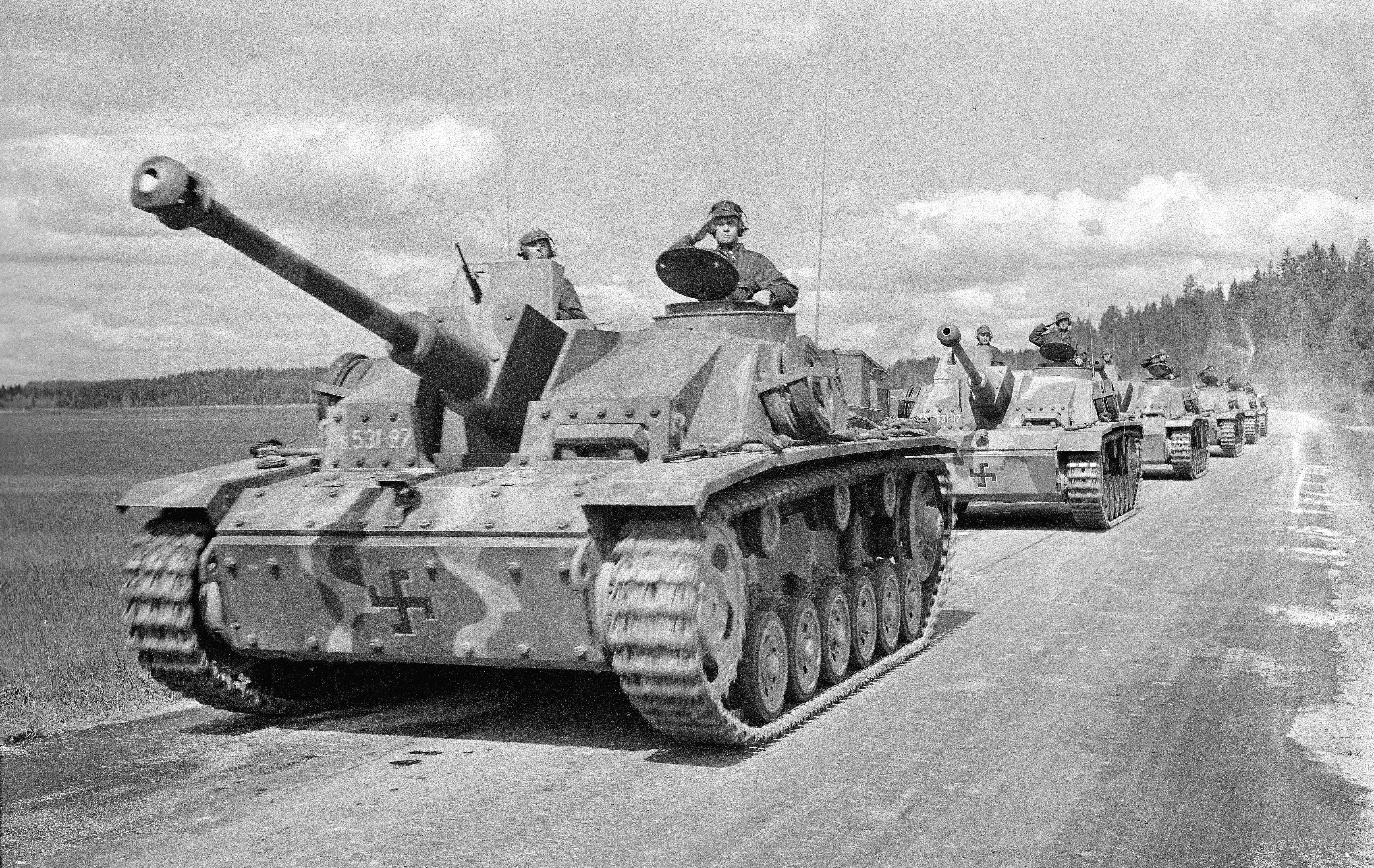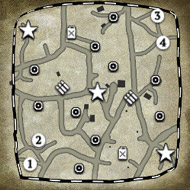Hello and welcome to the first episode of "The Theatre of History"! As chosen by you the community, we now present the StuG III and its variants.
Originally the StuG was conceived as an assault support gun to spearhead fortified positions seen in World War I, because infantry and military strategy at the time could not engage bunkers and pillboxes effectively. The solution was realized in 1935 by then German Oberst (equivalent to Colonel) Erich von Manstein, who proposed the Sturmartillerie ("assault artillery") unit to provide direct-fire support, with prototypes built by Daimler-Benz AG. Design requirements were to mount a 7.5cm artillery piece on a low-profile vehicle.
To reduce development costs and satisfy the height requirement, a casemate superstructure was mounted onto the already-developed Panzerkampfwagen ("armored combat vehicle", or Pz.Kpfw.) III chassis. The Panzer III proved to be a lightweight and mobile vehicle. Due to the lack of rotating turret, the resulting design was simpler, had a lower profile, could be camouflaged easily, and was much less expensive than producing contemporary turreted tanks. A StuG III cost roughly 82,000 Reichmark to produce while the Panzer Kpfw. III would cost 105,000 Reichmark.
As mentioned, the StuG featured no rotating turret and this would be seen as one of its greater disadvantages. Instead of a functioning rotating turret, StuG crews would have to move and orientate their vehicle properly before being able to fire. Fine alignments in aim were possible due to a ball joint in the weapon mechanism. However, no where near as effective as a rotating turret.
The first variants of the StuG mark A-E, dubbed the “Ausführungen”, were armed with the short 7.5cm-StuK 37 L/24 and had increased frontal armour plates of 50mm thickness. They were produced from January 1940 until March 1942. The first deployment in combat was on the western front during the “Blitzkrieg” against France, Belgium and the Netherlands. The StuGs were organised in independent batteries, each battery equipped with 6 vehicles, the “Sturmgeschütz-Batterien” 640, 659, 660 and 665.

A StuG III Ausf. B in Belgium
Come 1941 the batteries were combined to “Sturmgeschützabteilungen” which consisted of three batteries each. Resulting in a distribution which lead to every Abteilung having a total of 18 StuGs in use. After the first encounters with the heavy KV-1 tank and the T34 medium tanks, the StuG Ausf. F was developed and started production in March 1942. It got the high-velocity 7.5cm-Stuk 40 L/43, which could be used to penetrate the armour of soviet tanks in normal combat-range. This allowed to StuG to play a bigger role in the area of tank destroying as well as holding its infantry supporting role. Alongside this weaponry upgrade the StuG received additional frontal armour plates, increasing it from 50mm to 80mm.

A StuG III Ausf. F with the 7.5cm-StuK 40 L/48
From June 1942 onwards, the gun of choice was the even longer and better 7.5cm-Stuk 40 L/48. In September, the Variant F was improved by now using the chassis of the Panzerkampfwagen III Ausf. J and L which had an increased level of rear armor. Further developments of the StuG would now feature this StuK 40 L/48 as standard equipment, which made the StuG more durable in combat. From this modification on, the StuG was mainly used as a tank destroyer and helped to compensate the losses of battle tanks. During this progress, the “Sturmgeschützabteilungen” were resolved and completely transformed tank destroyer regiments.
The last Variant of the StuG was the Ausführung G which was produced from December 1942 until the war was almost over in March 1945. It had all the feautures of the Ausführung F/8 plus a mounted MG34 protected by a shield for Infantry-defence. Beginning in May 1943 the Ausführung G and F/8 were equipped with side armor skirts and the frontal armour plates were changed to a total of one plate with an armour of 80mm instead of two plates (50mm+30mm).

StuG III Ausf. G with the typical side skirts
Through the course of WWII the German forces were not the only ones to utilize the StuG assault vehicle. During 1943 to 1944, the Finnish Army received a total of 59 StuG III G variant vehicles. 30 in 1943 & 29 in 1944. These were supplied by Germany and were given for the purpose of fighting off the Soviet Union as Germany's demise became more and more realistic. The 30 that saw action in 1943 performed to a very high standard, they had a total of roughly 87 confirmed tank destroys while only losing eight StuG III's. It was noted however that some of those eight StuG's that were destroyed were destroyed purposely to avoid them falling into Soviet hands. The 29 received in 1944 however saw very little action. While in some situations this would lead to decommission, these StuG's would go on to serve in the Finnish Army all the way through to the 1960s, becoming nicknamed 'Sturmi'. Many of the Finnish StuG's have been restored and looked after, surviving still to this very day. A lot of these StuG's are housed at the Finnish Armour Museum or by private owners. It's saddening yet also uplifting to think that out of the total of 59, 36 StuG's are still around. Some destroyed in combat, others destroyed for 'target practice'. However, uplifting to think that there are independent owners and museums who work to restore and acknowledge the solid work and somewhat legacy of the StuG.

Finnish StuG Ausf. G without the skirts
Some technical terms explained for better understanding:
Sturmgeschützabteilungen = Storm/Armored assault battalion; Sturmgeschutz is pretty much the StuG, an armored assault gun. The Abteilung is either a detachment or a battalion that is affixed or attached at a regiment/division/brigade level. They're a group of 'tanks' that had varying amounts of independent operation freedom. Depending on the needs of wartime, they would be shipped elsewhere (attaching to other divisions) where there was a need for them.
StuK 40 L/48 = Sturmkanone, or assault gun. The 40 bears its name from the 7.5cm PaK 40, which was developed 1939-1941 and bore its name from the year of its development. The L/43 and L/48 refers to the length of the barrel in relation to its caliber. The L/43 would be 43 times the length of 7.5cmm, the L/48 is 48 times that. Generally, the longer the barrel the higher the velocity of the shell firing out of it, since the shell has had more time to accelerate, and more propellant is used for the shell to propel it out. That's why the Panther's KwK 42 L/70 actually has better penetration than the Tiger's KwK 36 L/56, and fired its shell at a higher muzzle velocity.
We hope you enjoyed this first edition of the "The Theatre of History". Look for more coming soon on the COH2.ORG portal. Please post your comments below.












 cblanco ★
cblanco ★  보드카 중대
보드카 중대  VonManteuffel
VonManteuffel  Heartless Jäger
Heartless Jäger 